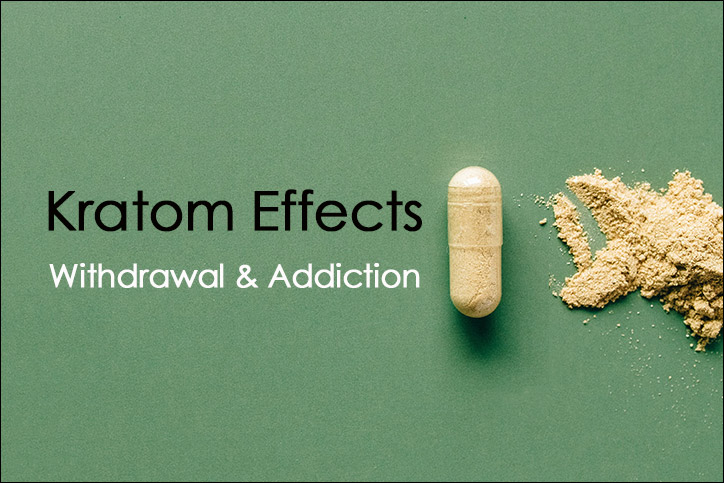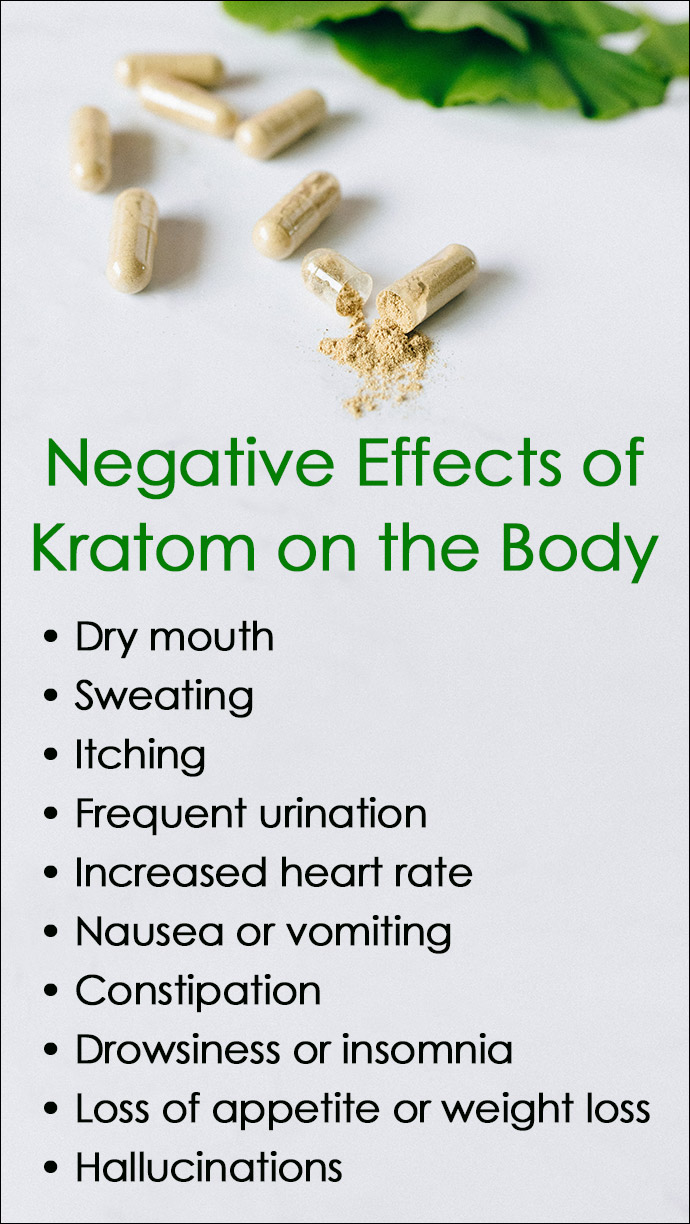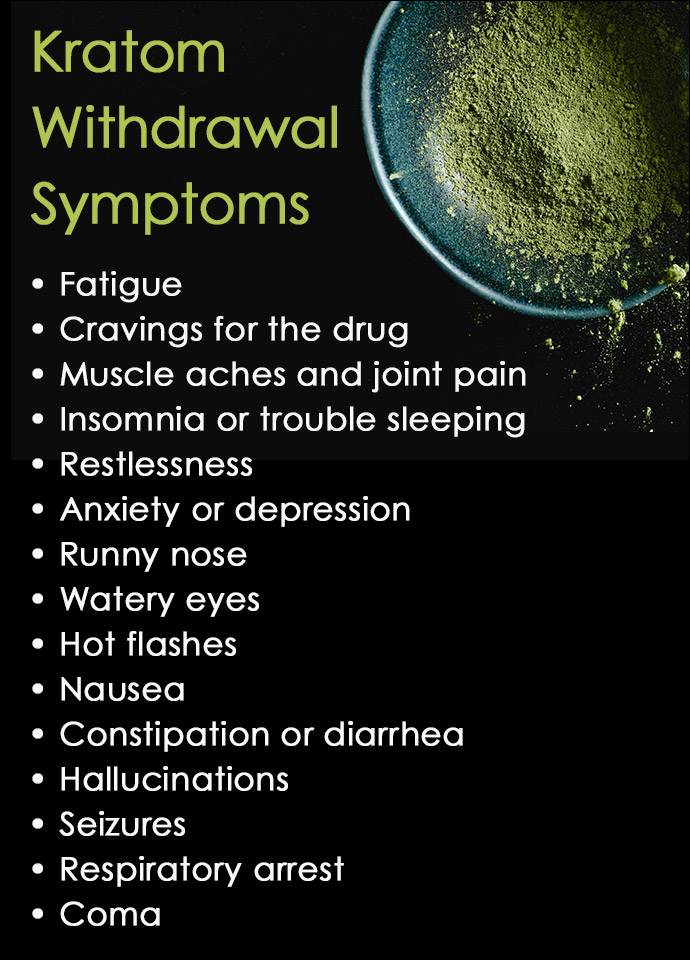Table of Contents
Kratom effects, withdrawal symptoms, and potential for addiction have raised questions about the safety of this popular herbal supplement.
Many people use kratom to reduce pain, anxiety, depression, and other conditions, although it does come with some risks.
Despite the fact it grows naturally and is not considered an illegal drug, most regular users fail to consider any possible harm until it’s too late.
For anyone considering, or already using the herbal supplement, it’s important to understand the negative effects of kratom and the possible addiction and withdrawal risks to avoid health complications.
What is Kratom?
Kratom is a tropical evergreen tree native to Southeast Asia known as Mitragyna Speciosa.
The leaves of the kratom tree have been used for centuries in areas where it grows as a stimulant and natural way to manage pain.
Today, the kratom leaf is ground into a fine powder and sold online, in gas stations, and smoke shops as an herbal supplement.
While it can be found in leaf form, it is commonly purchased in capsules or powder to be made into a tea.
It is used recreationally for the euphoric kratom effects and medicinally to relieve pain, improve focus, and even as an alternative to opioids.
The Substance Abuse and Mental Health Services Administration’s (SAMHSA) National Survey on Drug Use and Health reported that 1.7 million Americans aged 12 and older used kratom in 2021.
Kratom contains psychoactive alkaloids that affect opioid receptors in the brain. While the desired effects include pain relief, euphoria, and increased energy, the potential negative side effects range from nausea and constipation to dependence, addiction, and withdrawal symptoms.
What are Typical Kratom Effects?
The effects of kratom depend on a variety of factors including the dose, strain, an individual’s tolerance, frequency of use, and other factors.
Kratom Effects at Various Dosage Levels
When ingested in low doses of 1 to 5 grams, the kratom effects are stimulating like caffeine. Much like coffee, people feel energized, alert, more sociable, and it can improve focus and concentration.
With moderate doses of 5 to 15 grams, the drug can have sedative or euphoric effects similar to opioid drugs, with feelings of pleasure and lowered sensations of pain. Some people may feel numb or relaxed.
High doses over 15 grams can act as a sedative, with hypnotic effects. Some individuals describe feeling sedated yet focused. Very high doses may cause fatigue and loss of motor coordination.
Kratom Strains
There are nearly 40 different strains of kratom sold online that relate to the color and country or region where it was grown. The National Library of Medicine describes some of the different kratom strains.
- White Vein strain produces a stimulating sensation to boost energy
- Red Vein strain has sedating effects for pain relief and relaxation
- Green Vein strain provides a balance between stimulation and sedation
Negative Effects of Kratom on the Body
In addition to the pleasurable psychoactive kratom effects, it can also have negative effects on the body including:
- Dry mouth
- Sweating
- Itching
- Frequent urination
- Increased heart rate
- Nausea or vomiting
- Constipation
- Drowsiness or insomnia
- Loss of appetite and weight loss
- Hallucinations
Most kratom effects begin within 5 to 10 minutes after ingesting it and may last for 2 to 5 hours depending on the dose, strain, a person’s tolerance, and the presence of food in the system.
What Areas of the Brain Does Kratom Affect?
Kratom use has shown to affect several regions and neurotransmitters in the brain, specifically opioid receptors.
Opioid Receptors
One of the main ways kratom works is by activating opioid receptors in the brain. The drug binds to opioid receptors and releases endorphins that deliver pain-relieving, euphoric, and addictive effects.
People who have an addiction or dependence to opioids are attracted to Kratom as a way to stop using opiate drugs.
Dopamine
Kratom use can boost dopamine, which is a “feel-good” neurotransmitter in the brain that plays a role in emotions, reward, and motivation behaviors. The dopamine boost leads to feelings of pleasure.
Serotonin
Kratom contains many types of alkaloids that can increase serotonin, that is known to positively stimulate mood and emotions.
Unfortunately, when mixed with similar substances it can cause the body to produce too much serotonin and lead to Serotonin Syndrome.
GABA
Kratom may increase the release of GABA, a neurotransmitter that promotes calm and relaxation related to the sedative effects of high doses.
Kratom impacts many areas of the brain and neurotransmitters that produce a blend of stimulant and depressant effects, but this also contributes to kratom’s addictive potential.
Kratom Addiction
Despite being viewed by some as an alternative to opioids, there is a definite risk of kratom addiction, dependence, and developing a tolerance.
Because the active compounds in kratom impact the brain’s opioid receptors, regular or excessive use can cause a tolerance that requires an individual to use higher doses to get the same results as when they started using it.
Prolonged use can lead to drug cravings and kratom withdrawal symptoms when a person attempts to stop using it.
A study published by National Library of Medicine shows that over 50 percent of regular users with more than six months of use experienced a severe kratom dependence, and 45 percent had a moderate dependence.
The users developed kratom withdrawal symptoms that included muscle spasms, pain, sleep issues, fever, decreased appetite, and diarrhea.
Factors That Influence Kratom Addiction Include:
- Dose – Higher doses promote tolerance, dependence, and addiction
- Frequency of Use – Using kratom several times per day increases the risk of addiction
- Genetics – Genetics and a family history of substance use disorder plays a role in addiction susceptibility
- Reasons for Use – Using kratom to get high versus using it for pain may affect addiction rates
Kratom addiction is one of the negative side effects and some have estimated that 10 percent of recreational users will become dependent after two years of regular use.
Kratom Withdrawal Symptoms
Kratom withdrawal symptoms can occur for regular users who stop taking the drug after a period of heavy use and are similar to the symptoms of opioid withdrawal.
Withdrawal will generally develop within 12 to 24 hours after the last use and the symptoms may peak for nearly a week after quitting.
Kratom Withdrawal Symptoms Can Include:
- Cravings for the drug
- Muscle aches
- Joint pain
- Fatigue
- Insomnia or trouble sleeping
- Restlessness
- Anxiety
- Depression
- Runny nose
- Watery eyes
- Hot flashes
- Nausea
- Constipation or diarrhea
- Hallucinations
- Seizures
- Respiratory arrest
- Coma
The intensity and duration of kratom withdrawal is related to the length of use, amount used, body chemistry, and other substance use at the same time.
For most people, the symptoms will about last about one week, but some individuals may experience post-acute withdrawal lasting several months.
Using tapering techniques instead of abruptly stopping “cold turkey” can help reduce uncomfortable kratom withdrawal symptoms.
Users should not mix the herbal supplement drug with other medications or substances and watch for signs of kratom addiction or dependence to seek treatment before the problem worsens.
Kratom Addiction Treatment
Treatment for kratom addiction and withdrawal is similar to opioid dependence.
The first part of treatment begins with a medically-supervised detox to ease and manage uncomfortable withdrawal symptoms as the drug leaves the system.
Common medications used include anti-anxiety meds, non-opioid pain relievers, and others to help with sleep and nausea.
Medication Assisted Treatment (MAT) can be helpful during withdrawal and after detox has been completed to ween an individual and control cravings.
An inpatient treatment program follows detox and includes individual and group therapy sessions.
The goal is to identify any underlying causes of kratom addiction and teach coping skills to overcome dependence issues and prevent a relapse.
Cognitive Behavioral Therapy techniques are effective for changing addictive thought patterns and behavior.
Lifestyle changes are encouraged to make healthy and positive daily adjustments to minimize exposure to triggers and addictive behaviors.
The most effective treatment programs use a combination of approaches tailored to each individual’s circumstances and level of addiction. Proper treatment is very effective for overcoming kratom addiction.
FAQs About Kratom
Is Kratom Legal?
Kratom is not listed as controlled substance and is currently legal to use at the federal level in the United States. However, the FDA has raised concerns about the safety of kratom and has advised against using it.
Although kratom is federally legal, some states have banned it or are considering regulating or banning it. These states have banned kratom: Alabama, Arkansas, Indiana, Rhode Island, Vermont, and Wisconsin. Some states have also imposed age restrictions for legal kratom use.
Other states currently have pending legislation to regulate or ban kratom and in some states, individual cities and counties have imposed local kratom bans.
The legal status of kratom is constantly changing so it’s important for users to understand the local and state laws to avoid legal issues.
Is Kratom an Opioid?
Technically, kratom is not an opioid, although it does interact with opioid receptors in the brain and it produces similar effects to an opioid high.
Kratom contains active compounds and alkaloids that bind to the mu-opioid receptors, delta-opioid receptors and kappa-opioid receptors, which is why it resembles drugs like morphine, codeine, and oxycodone.
Researchers are still studying whether the term “atypical opioid” may be more fitting for substances like kratom and the FDA considers it an “opioid-like drug.”
There are plenty of safer opioid alternatives than kratom for those who are taking it for pain management.
Does Suboxone Block Kratom Effects Like Opioids?
Yes, Suboxone can block kratom effects to some extent.
Suboxone contains two drugs – buprenorphine and naloxone. Both of these substances bind to and partially block opioid receptors in the brain. Since kratom works on these same opioid receptors to produce its effects, Suboxone can interfere with the effects of kratom.
Buprenorphine binds tightly to opioid receptors and prevents other opioids (or in this case kratom’s compounds) from binding. This means users may not feel the kratom effects like pain relief, euphoria, or sedation after taking Suboxone.
Naloxone in Suboxone can also block kratom to some degree, but not as effectively as buprenorphine.
How Long Does Kratom Last?
The effects of kratom generally last anywhere from 2 to 7 hours after ingestion, but this is determined by a variety of factors including the dose taken, a person’s tolerance, similar substances used at the same time, and other variables.
A low dose of 1 to 5 grams might last for 2 to 3 hours for some people, while a high dose of 15 grams or more could last for 5 to 7 hours or longer.
It also depends on the type ingested. Capsules will take longer to dissolve and take effect, whereas tea made from the powder will be faster acting and may not last as long.
Regular kratom users with a tolerance tend to experience shorter effects and duration than those who do not use it as often.
Is kratom bad for your liver?
There is some evidence that kratom could potentially be bad for the liver in high doses or with frequent long-term use.
Kratom contains over 40 different alkaloids, some of which have been shown to be potentially toxic to the liver in animal studies. In particular, the mitragynine may be associated with liver injury.
Kratom use has been linked to acute liver injury, liver toxicity, hepatitis, and even liver failure requiring transplant in extreme cases.
Some of these are similar to cirrhosis of the liver symptoms.
Risk factors include using kratom frequently for extended periods of time, consuming high doses, and combining it with other medications or alcohol.
Because of this, anyone with liver issues should avoid using kratom.






